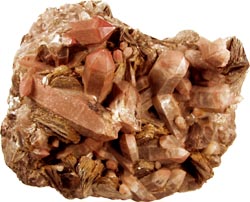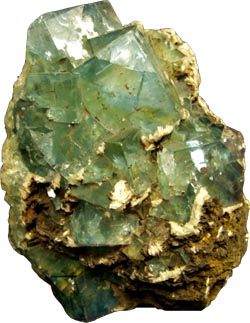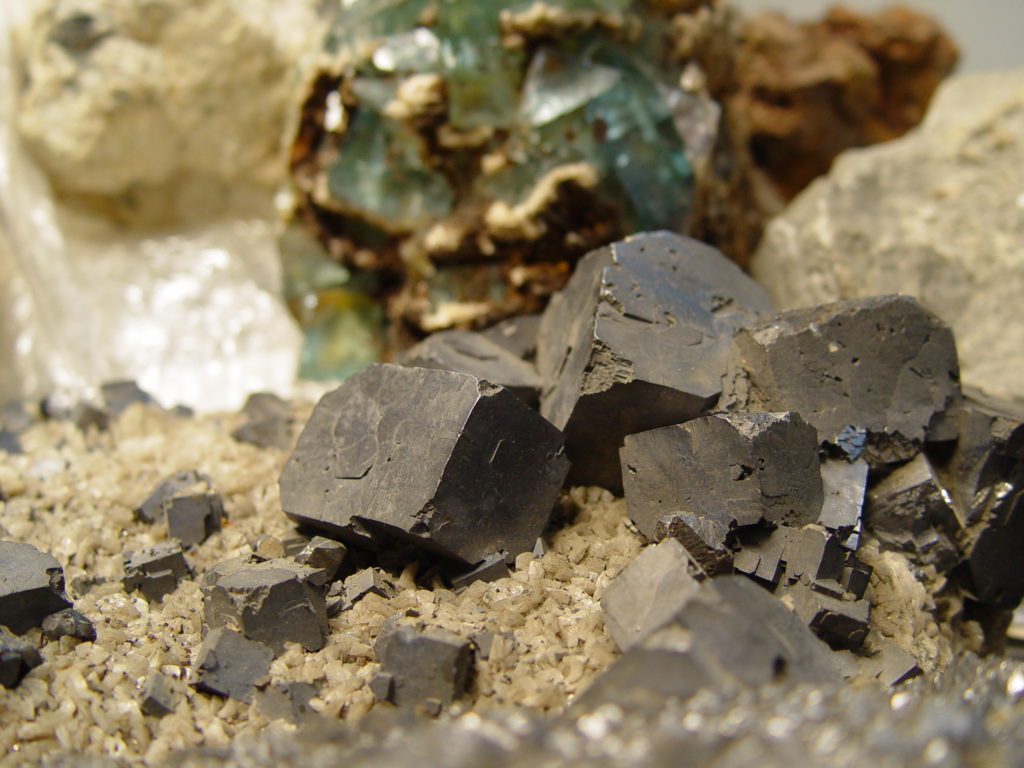Large gem crystals
 Minerals with crystals are still attached to the rock in which they have been formed are especially attractive. This rock material is called the matrix. Different types of minerals sticking on one piece of matrix is called a group. The name of the group depends on the predominant type of mineral, e.g. a group of crystals of quartz or tourmaline. Groups of minerals that are highly attractive, e.g. for public display, are called gem crystals.
Minerals with crystals are still attached to the rock in which they have been formed are especially attractive. This rock material is called the matrix. Different types of minerals sticking on one piece of matrix is called a group. The name of the group depends on the predominant type of mineral, e.g. a group of crystals of quartz or tourmaline. Groups of minerals that are highly attractive, e.g. for public display, are called gem crystals.
Furthermore minerals can be encountered as geodes or druses. These are cavities in the rock that might have been built in different ways, but later they were completely or partially filled with crystals.
One possibility of formation is for example the inclusion of gas bubbles into the liquid magma that was later consolidated to form a rock. Frequently cavities were built at the joint of two rock packages that were displaced from each other during the formation of mountains (tectonics). The later are called rift cavities. Well-known examples of druse minerals are amethyst druses from Brazil and agate druses from Idar-Oberstein, Rheinland-Pfalz, in Germany.
The Geosciences Collection owns a particularly valuable collection of gem crystals, groups and druses since 1997 – the collection of Arthur von Gwinner.
The Gwinner collection
 The collection of the former head of a bank Arthur von Gwinner went through an odyssey during its history. The first specimens became a part of the Gwinner collection back in 1883, when Arthur von Gwinner was still an employee of a bank in Madrid. One day a Catalan visited him in his office and showed him ores with a certain amount of copper and nickel. Arthur von Gwinner was asked to finance and manage the mining of these lagerstatten close to Malaga in southern Spain. Already in these days he had a strong self-interest in minerals and that led to his exposure without having seen the mining locality. After first payments there was no response and Gwinner travelled to the aforesaid mining place. He met the Catalan who was surprised to see him and after a common field-trip he was sure that the mines would not make a sufficient profit. A few years later he sold the mines again without loss.
The collection of the former head of a bank Arthur von Gwinner went through an odyssey during its history. The first specimens became a part of the Gwinner collection back in 1883, when Arthur von Gwinner was still an employee of a bank in Madrid. One day a Catalan visited him in his office and showed him ores with a certain amount of copper and nickel. Arthur von Gwinner was asked to finance and manage the mining of these lagerstatten close to Malaga in southern Spain. Already in these days he had a strong self-interest in minerals and that led to his exposure without having seen the mining locality. After first payments there was no response and Gwinner travelled to the aforesaid mining place. He met the Catalan who was surprised to see him and after a common field-trip he was sure that the mines would not make a sufficient profit. A few years later he sold the mines again without loss.
Later Gwinner’s career was more successful and consequently he was able to buy a country estate in Berlin at around 1910 where he build a pavilion in which he housed the minerals purchased between 1902 and 1911. The more than 2000 specimens include colourful tourmalines from Brazil, topaz and gold-bearing quarz from the Ural mountains, galena from Missourim Arizona and the Harz mountains.
The land reform in the former German Democratic Republic caused the specimens to be wrapped by a geologist and send via Greifswald and Wismar finally to Halle. The grandson of Arthur von Gwinner, Dr. Wolfgang Klingler, discovered the collection after the reunification of Germany and gave it to the University of Bremen on permanent loan.

The following chart of specimens of the Gwinner collection is subjective. The whole variety of 1162 different gem crystals can not be shown, but it can be appreciated that the collection comprises material of a large number of different localities and minerals. Because of the high optical attractiveness the specimens of the Gwinner collection were regularly presented in public presentation of the Faculty of Geosciences of the Bremen University.
| Mineral | Locality | Country |
| Antimonite | Przibram, Bohemia | Cech Republic |
| Arsenopyrite | O’radua | Hungary |
| same | Freiberg in Saxony | Germany |
| Aquamarine | Tirolia | Austria |
| Calamine | Chihuahua | Mexico |
| Disthen | Pisafornia Ch’ironico, Tessin | Switzerland |
| Enhydros | Santa Eugenia | Uruguay |
| Fluorite | Durham, Cumberland | United Kingdom |
| same | St. Andreasberg, Harz mountains | Germany |
| Franklinite | Franklin Fornace, New Jersey | USA |
| Gypsum | Madrid | Spain |
| Goethite | Herdorf, Westphalia | Germany |
| Gold | Ballarat, Victoria | Australia |
| same | Beresowsk, Ural | Russia |
| Garnet | Bodö | Norway |
| Haematite | Rio Marina, Isle of Elba | Italy |
| Ilmenite | Springhofe | Namibia |
| Copper | Bergmannstrost, Hessen | Germany |
| Lazuli | Werfen, Salzachtal | Austria |
| Magnetite | Lapland | Sweden |
| Olivenite | Collahuasi | Chile |
| Feldspar | Janckamiyana, Omi | Japan |
| same | Baveno | Italy |
| Pyrite | Biskra | Algeria |
| Pyroxene | Horgaard | Finnland |
| Rhodochrosite | Sequache County, Colorado | USA |
| Tetraedrite | Huanchaca, Pulacayo | Bolivia |
| Tourmaline | Wakefield, Quebec | Kanada |
| Bismuth | Schneeberg, Saxony | Germany |
| Cinnabar | Idria, California | USA |
References
- Spangenberg, P. (1998): “Mit Sachverstand und Schönheitssinn”. – Weser-Kurier, Nr. 222: 14; Bremen.
- Kuster-Wendenburg, E. (1999): Der Bremer Stein und die Dinosaurier. Die Geschichte einer Sammlung. – 95; Aschenbeck & Holstein, Bremen.
